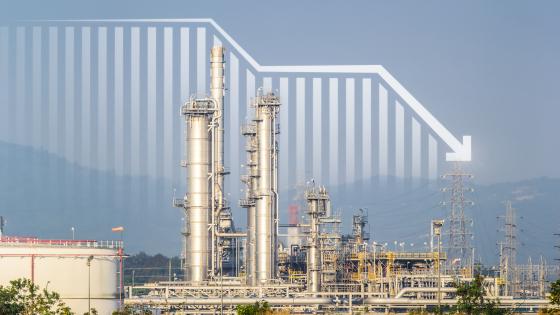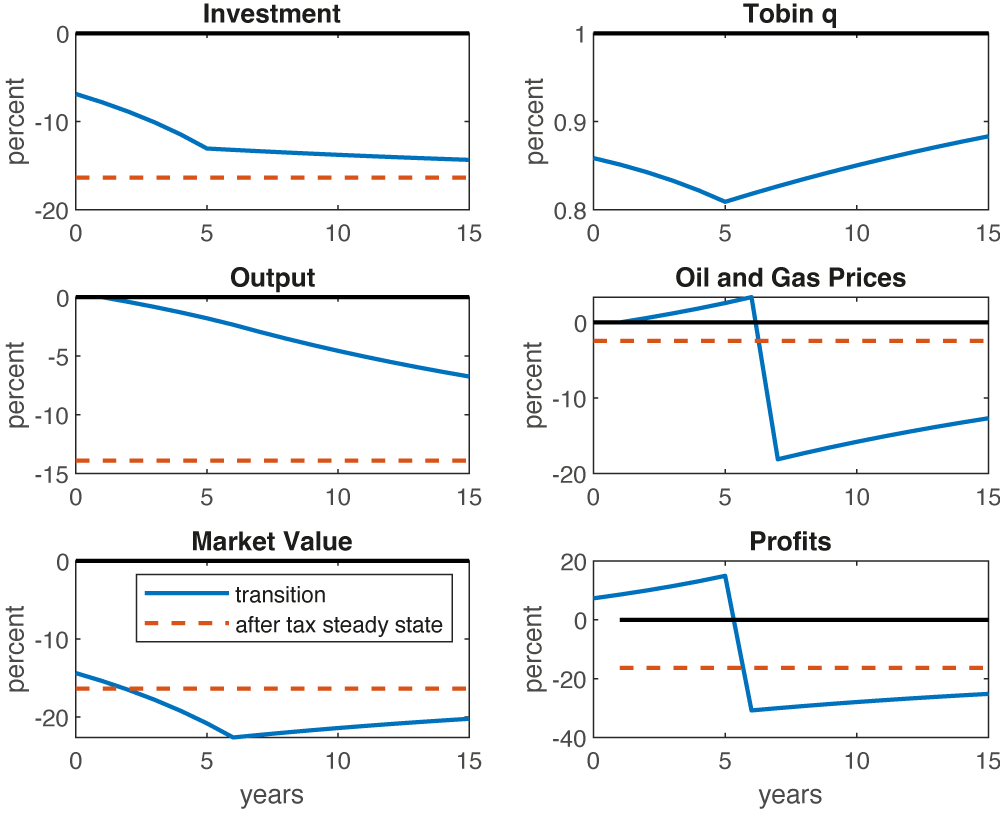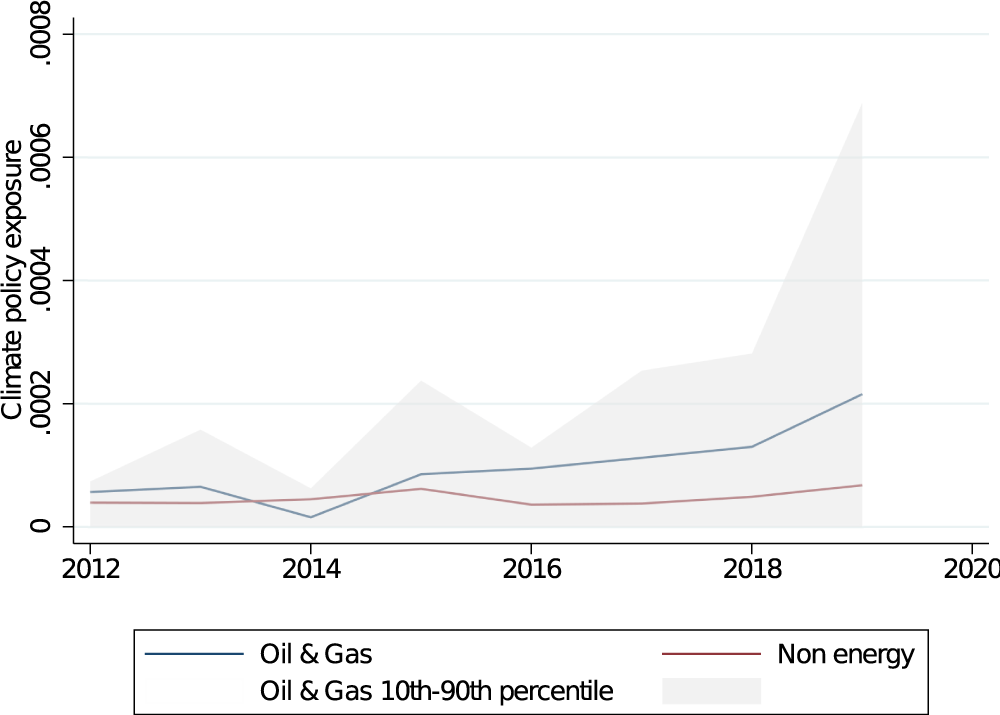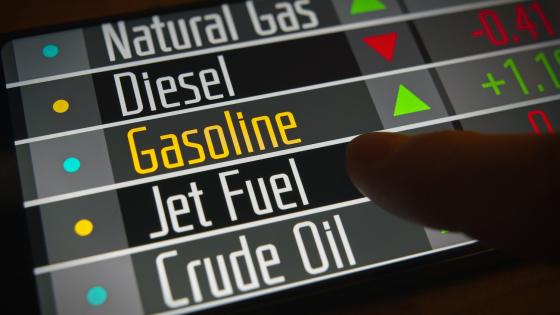A smooth energy transition requires moving away from fossil fuels at a pace that is commensurate with the adoption of renewable energy. This challenging balancing act is complicated by the forward-looking nature of energy investment and extraction, which saddles companies and investors with the challenging task of correctly anticipating future revenues in a rapidly changing market and policy environment. This poses a transition risk that is specific to each company and sector, but that for most oil and gas companies represents a large downside risk in the form of the potential loss in the value of their physical and financial assets (van der Ploeg and Rezai 2020).
The literature has typically split transition risk into technology risk and climate policy risk. The latter seems especially relevant for oil and gas companies. In contrast to previous transitions, such as the one from biomass to coal in the 18th and 19th centuries that underpinned the first industrial revolution, climate policies are crucial for controlling the direction and pace of the current transition. Since the adoption of the Paris Agreement in 2015, many countries have pledged and announced targets to reduce carbon emissions in the not-so-distant future, sometimes coupled with policies that, once ramped up, should make these targets feasible. While the energy transition is a slow-moving process it has a level of predictability that has already induced some investors to react, for example in the form of fossil fuel divestment pledges (Pless 2023).
Banks and investors are pricing in climate policy risk
A large and rapidly growing literature has already analysed the effects of climate transition risks on various dimensions relevant to private firms (Ongena et al. 2021). For example, research shows that risks related to environmental regulation are increasingly driving up the cost of capital for high emitters in corporate loan markets, through syndicated loans (D’Arcangelo et al. 2023), corporate bonds, and higher interest rates charged by banks to dirtier firms (Delis et al. 2019). Investors are increasingly pricing in climate policy risks in Germany (Sen and von Schickfus 2020) and in the US (Bolton and Kacperczyk 2021). In theory, a higher cost of capital due to stricter climate policies should reduce investment by affected firms. None of the papers in this literature, however, has specifically analysed the impact of climate policy exposure on oil and gas investment which, in turn, has direct implications for energy supply, energy prices, and energy security.
Two competing theories of the effect of climate policies on oil and gas investment
Investment by oil and gas firms peaked in 2014 amid the shale boom, reaching 0.9% of global economic output – the largest share in three decades. Five years later, investment had dropped to 0.5% of global output, and then fell even further during the pandemic. The decline in investment was especially pronounced for publicly traded companies, which had cut investment in oil and gas more than their state-owned counterparts. Such outlays fell more notably in the Americas and Africa as opposed to the Middle East and Russia. Bogmans et al. (2022) find that lower oil and gas prices can explain some, but not all of the decline in oil and gas investment after 2015, which suggests that (expectations of) stricter climate policies may have also played a role.
Figure 1 Investments in the oil and gas sector versus the rest of the economy
Source: IMF
The qualitative impact on oil and gas investment of announcing stricter future climate policies is a priori ambiguous. Two opposite anticipation effects could be at work: namly the divestment effect (Bauer et al. 2018) and the ‘green paradox’ effect (van der Ploeg and Withagen 2015). In a recent paper (Bogmans et al. 2023), we explore two distinct theoretical frameworks, each of which embodies one of these two anticipation effects. The two models capture distinct aspects of the oil and gas industry, and yet, the frameworks give starkly different results: while investment declines in response to the carbon tax announcement in the first framework, it increases in the second – and vice versa for oil and gas prices.
In the neoclassical model, a carbon tax announced today and implemented with certainty at a future date causes an immediate drop in the value of installed capital (i.e. Tobin’s Q), as the carbon tax reduces future demand for oil and gas. Firms in the oil and gas sector react by cutting investment immediately to initiate the costly transition to a lower capital stock. Production of oil and gas, however, declines only slowly as the capital stock gradually erodes with capital depreciation outweighing investment. In the initial phase of the transition oil and gas prices slowly increase on account of lower production, but then fall once the carbon tax is implemented (Figure 2).
Figure 2 Declining oil and gas investment in the neoclassical model
Note: Response of investment, Tobin’s Q, output, and prices of OG firms to a delayed carbon tax in the Neoclassical model. The dashed (solid black) line is the new (initial) steady state. Charts illustrate the case of a permanent 25% carbon tax, announced at time zero and implemented with certainty after five years.
Source: IMF staff calculations.
In the green paradox model, the extraction (and investment) path immediately jumps up in the pre-tax period in response to the carbon tax announcement as producers seek to sell more oil today by frontloading investment and extraction before demand destruction from the carbon tax sets in. This leads to lower prices and higher oil and gas consumption today (i.e. a green paradox). In the post-tax period, instead, extraction of oil and gas falls (Figure 3). Furthermore, we discover a non-monotonic relationship between the length of the policy delay and the magnitude of the green paradox. While for initial increases in the delay the green paradox worsens, at some point further delays to the implementation of the carbon tax will soften the green paradox, until the policy, too far into the future, becomes irrelevant. Since the balance of the two opposite anticipation mechanisms is a priori unclear, only empirical analysis can determine the net direction of the overall investment response.
Figure 3 Effects of a carbon tax in the Hotelling model
Note: Response of investment/extraction in Hotelling-type model. The chart illustrates the case of a permanent carbon tax (τc) on oil consumption of 75%, announced at time zero and implemented with certainty after five years (t0) and a depletion period of 50 years. R(t) stands for extraction.
Source: IMF staff calculations.
Climate policy exposure and uncertainty have reduced fossil fuel investment
Our regression analysis employs firm-level measures of climate policy exposure (Figure 4) and climate policy risk as sources of plausible exogenous variation in companies’ investments, which are influenced by both current and expected climate policies. These measures are derived by Sautner et al. (2023) from transcripts of earning calls of publicly listed firms using machine learning and keyword discovery algorithms to identify climate change conversations. The exposure measure should capture revisions in expectations of climate policies and their impact on the firm’s profitability while the risk measure should reflect the associated uncertainty.
Figure 4 Firm-level measures of climate policy exposure
Note: Average climate policy exposure in the oil and gas sector and other sectors. The grey bands refer to the 10th and 90th percentile of the exposure index for the oil and gas sector.
Source: IMF staff calculations on Sautner et al. (2023) data.
Using 117 publicly traded oil and gas firms (accounting for about 40% of global oil production) and a control group made up of non-energy firms, a panel regression over the period 2012-2019 shows that a one standard deviation increase in exposure to climate policy leads to a reduction of around 3% in investment by a typical oil and gas company. Climate policy risk has an even stronger effect than exposure (i.e., the first moment), with a typical shock in uncertainty reducing investment by around 4%. For the control group, instead, a one standard deviation increase in climate policy exposure increases investment by 4.9% – for non-energy firms, the energy transition may, on average, represent more of an opportunity than a threat.
These effects are also economically meaningful. When aggregated across firms, estimates imply that upstream oil and gas investment fell by 6.5% between 2015 and 2019, i.e. a -1.45% annual rate. In its 2016 flagship report, the International Energy Agency (IEA) estimated that the implementation of all pledges announced up to that point, including the Paris Agreement, would have resulted in an average annual decrease in oil and gas investments of 0.7% through 2040, relative to a business-as-usual scenario in which climate policy stringency remained at its pre-2015 levels (IEA 2016). Our empirical evidence suggests that the actual investment trend has been even lower, pointing to potential underinvestment as global oil and gas demand is curbed only in the more distant future.
The cut in investment can, thus, be rationalised as the optimal response of oil and gas firms to a downward revised path for oil and gas demand, aimed at minimising (the risk of) stranded assets. These findings support the Neoclassical investment theory which suggests that announcing a stricter path of climate policies and regulations should (1) reduce investment and (2) increase oil and gas prices and, thus, oil and gas free cash flow, in the initial stage of the energy transition. While in the neoclassical investment model a higher cost of capital induced by stricter climate policies could lead to a decline in investment too, only future demand-side policies would also lead to a contemporaneous increase in free cash flow for oil and gas firms, which seems more consistent with recent events.
Policy implications: The need for credible climate policies and reduced uncertainty
Based on our empirical evidence, it is conceivable that overly optimistic expectations about the pace of the energy transition coupled with climate policy uncertainty (delaying both fossil fuel and renewable investment) may result in a shortfall of the total energy supply. This, in turn, could lead to higher and more volatile fossil fuel prices. To guide market actors through the energy transition, a credible climate policy commitment by policymakers is needed. Clear and consistent signals by authorities about the direction of climate policy and the energy transition will reduce uncertainty, boost investment in renewable energy, and incentivise the proper amount of fossil fuel divestment.
References
Bauer, N, C McGlade, J Hilaire, and P Ekins (2018), “Divestment prevails over the green paradox when anticipating strong future climate policies”, Nature Climate Change 8(2): 130–134.
Bogmans, C, A Pescatori and E Prifti (2023), “The Impact of Climate Policy on Oil and Gas Investment: Evidence from Firm-Level Data”, IMF Working Paper No. 2023/140.
Bogmans, C, A Pescatori, E Prifti, M Stürmer and N Valckx (2022), “The pace of fossil fuel divestment. Commodity Special Feature”, in World Economic Outlook, April 2022, Chapter 1: 31-36.
Bolton, P and M Kacperczyk (2021), “Global pricing of carbon transition risk”, Journal of Financial Economics 142(2): 517–549.
D’Arcangelo, F M, T Kruse, M Pisu and M Tomasi (2023), “The effect of climate policies on firms’ financing and investment: new evidence and policy options”, VoxEU.org, 12 October.
Delis, M D, K De Greiff and S Ongena (2019), “Being stranded with fossil fuel reserves? Climate policy risk and the pricing of bank loans”, EBRD Working Paper 231.
IEA - International Energy Agency (2016), World Energy Outlook 2016.
Ongena, S, K de Greiff, M Delis and W Beyene (2021), “Too big to strand? Bond versus bank financing in the transition to a low carbon economy”, VoxEU.org, 4 December.
Kacperczyk, M and P Bolton (2021), “Global pricing of carbon-transition risk”, VoxEU.org, 24 March.
Pless, J (2023), "To Starve or to Stoke? Understanding Whether Divestment versus Investment Can Steer (Green) Innovation", Entrepreneurship and Innovation Policy and the Economy 2(1): 107-147.
Sautner, Z, L Van Lent, G Vilkov and R Zhang (2023), “Firm‐level climate change exposure”, The Journal of Finance 78(3): 1449-1498.
Sen, S and M-T von Schickfus (2020), “Climate policy, stranded assets, and investors’ expectations”, Journal of Environmental Economics and Management 100: 102277.
van der Ploeg, F and C Withagen (2015), “Global warming and the green paradox: A review of adverse effects of climate policies”, Review of Environmental Economics and Policy.
van der Ploeg, F and A Rezai (2020), “Stranded Assets in the Transition to a Carbon-Free Economy”, Annual Review of Resource Economics 12(1): 281–298.










